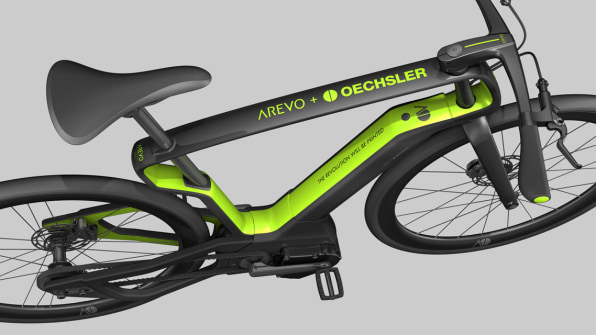Arevo’s new bikes are made from a thermoplastic embedded with carbon fiber, and can be printed locally, instead of waiting for parts to ship.
A typical bike sold in a U.S. bike shop today was made in China and shipped thousands of miles to the store. But a new bike-building robot makes it possible to make bikes locally–perhaps even in the shop itself, on demand–at roughly the same cost.
In a workshop in Silicon Valley, the startup Arevo is 3D printing samples of its first generation of bikes. A custom robot prints the company’s carbon fiber-embedded material using a process that can print in all dimensions, rather than just building layers like a standard 3D-printer–making it strong enough to print large objects like bikes or parts of an airplane. (The company plans to make a variety of industrial components, but chose to start with bikes to demonstrate its technology.)
Since the robot does all the work, there are no labor costs, it’s feasible to manufacture in the U.S. or Europe and avoid the carbon footprint of shipping bike componets across the ocean. The manufacturing process also has a lower environmental footprint. Right now, most carbon fiber bikes are made in a high-energy process that involves baking the frame in a huge oven for hours or days.
“There’s a number of problems with that,” says Arevo CEO Jim Miller. “Number one, it’s costly to do. It’s very energy intensive. It is incredibly environmentally unfriendly. If you see any composite today, whether it’s on a car or an airplane or a bike, there’s no way to recycle that. They basically put it in a landfill.”
The new material, a thermoplastic embedded with carbon fiber, is durable enough that the company says the bike may last longer than usual, also helping reduce its environmental impact (the material is five times stronger than titanium, and a third of the weight). When the bike reaches the end of its life, the material can be reused. “You basically grind [it] up, and you can use that to reprint something else,” says Miller.

Arevo also designed software that can be used to test parts of a design before it’s ever printed, saving more energy, materials, and time; the company claims that it has reduced the typical timeframe of designing a bike frame from 18 months to 18 days. Bike brands can design their own new bikes using the system, and the same software could be used to create custom frames for customers within a bike store. Arevo designed two bikes to demonstrate the technology–both a road bike and an electric bike that can connect to a smartphone to track data like battery life, speed, and distance–and bike brands can sell them as-is, or design new versions themselves.
“The beauty of 3D printing is you can build something with the economics of one unit, because there’s no tooling required,” says Miller. “Not only can we tailor the size, but we can also tailor the ride characteristics, too. Some people want a harder bike or a stiffer bike; some people want a softer, more compliant bike. Because that’s all software controlled, ultimately, we just dial that into the software recipe and then we print that particular recipe out.”
The first bikes will be manufactured at Arevo’s headquarters in Santa Clara, California. Because the machine doesn’t use hazardous chemicals or produce waste, it could be used anywhere, Miller says. “We will be next to another office complex, and the people next to us will be oblivious to the fact that we’re manufacturing bikes, because it will not look like a manufacturing plant,” he says.
The bikes will be in mass production next year.

![[Photo: Arevo]](https://images.fastcompany.net/image/upload/w_562)